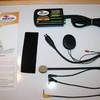
HIDs
Traditional automotive bulbs are either made of tungsten or halogen, both of which rely on a superheated filament for illumination. On the other hand, the bluish tint you see on HID-equipped vehicles is from a lighting technology that uses no filament whatsoever. HID bulbs create light much like a mercury vapor lamp: a high-pressure gas is excited between high-voltage electrodes. The bulbs are filled with xenon gas, which is why HID headlights are often referred to as xenon headlights. Now, with the flick of the headlight switch, the xenon gas turns into white-hot plasma light in seconds. A single HID bulb is so bright that it can handle the job of two incandescent filaments. Bright light with low voltage Once illuminated, HID light output is three times that of halogen, and as an added benefit, the ignited gas uses very low voltage, thereby reducing the load on the alternator. The light, now at a “hotter” color temperature than halogen, appears nearly white. The powerful white light makes distant street reflectors and signs highly visible to the driver. As HID light is more intense, the bulbs are typically placed behind projector beam headlight assemblies. These lenses allow the bright HID beam to be very focused, often with a very pronounced beam cut-off, or area where the light stops, to reduce glare to opposing traffic. In addition, most HID-equipped vehicles have standard beam leveling control, dropping and raising according to vehicle load and angle, to further prevent glare to other road users. Early HID headlights were only used for the low beam, with a halogen bulb reserved for high beam use. As reflector technology has improved, “bi-xenon” headlights (offering both a “low” and “high” HID beam) are offered on many vehicles today |
|



